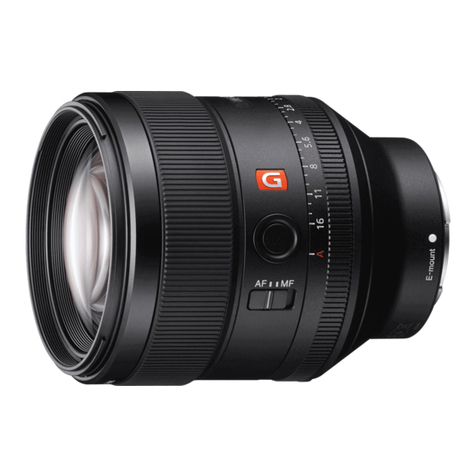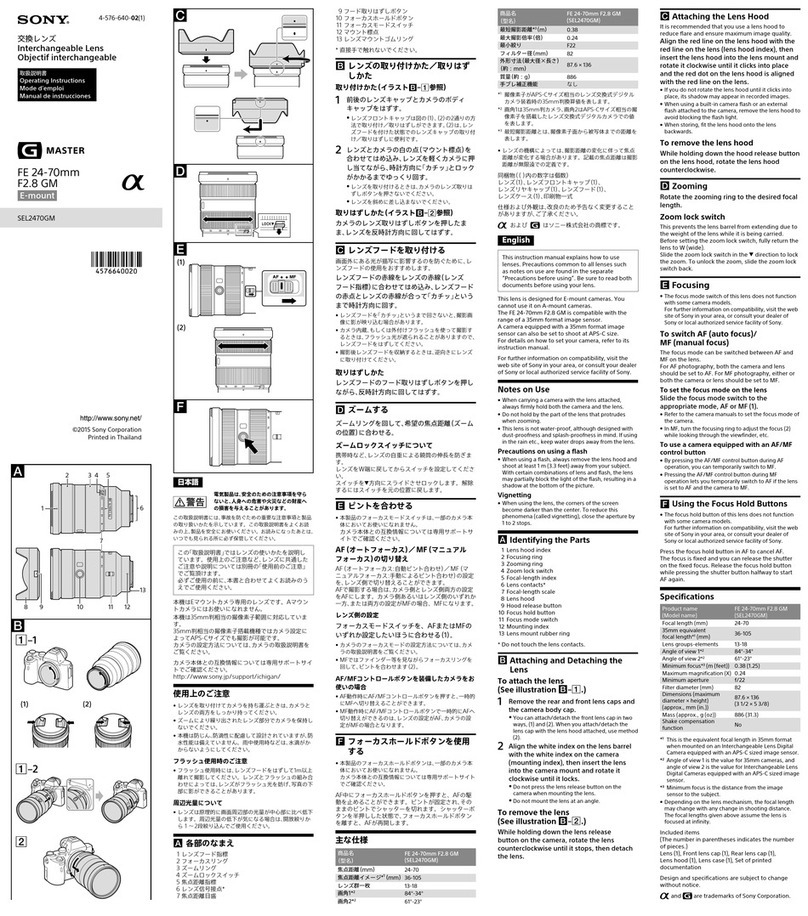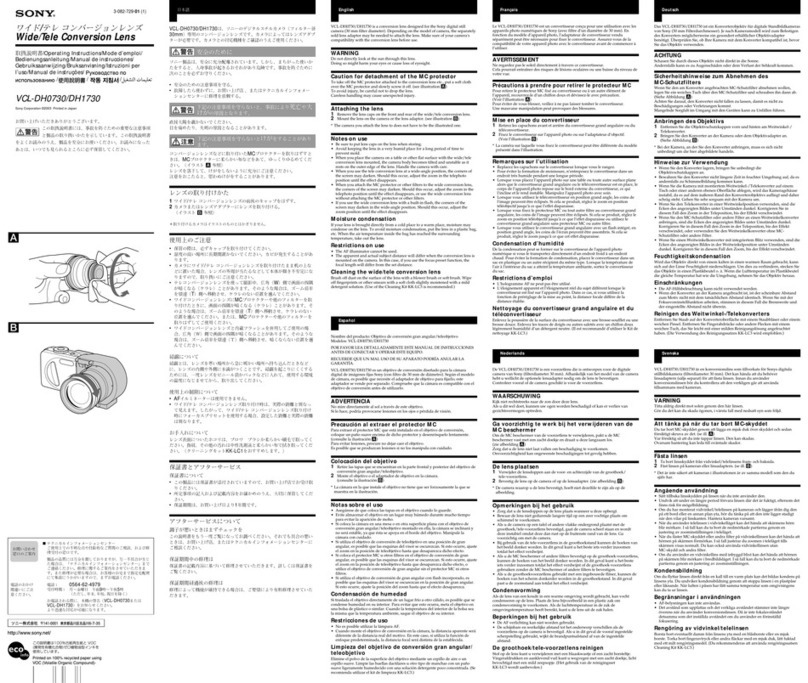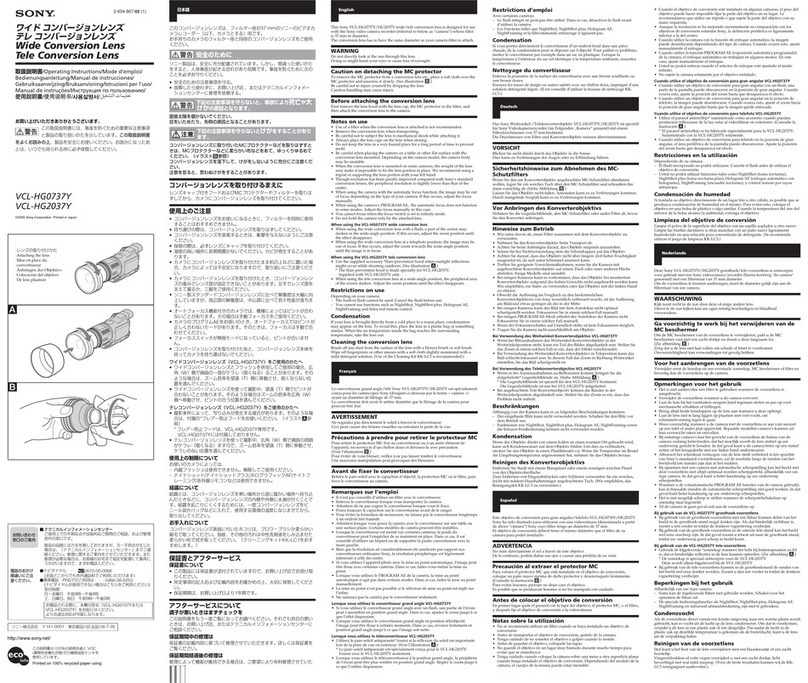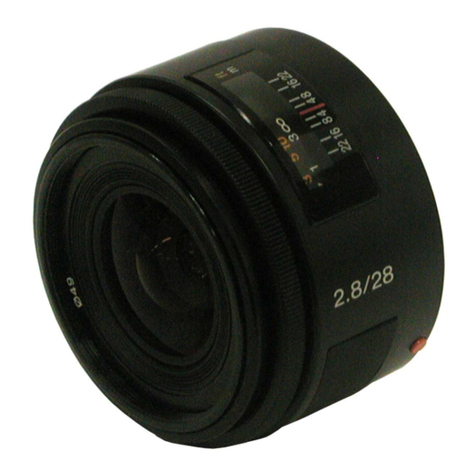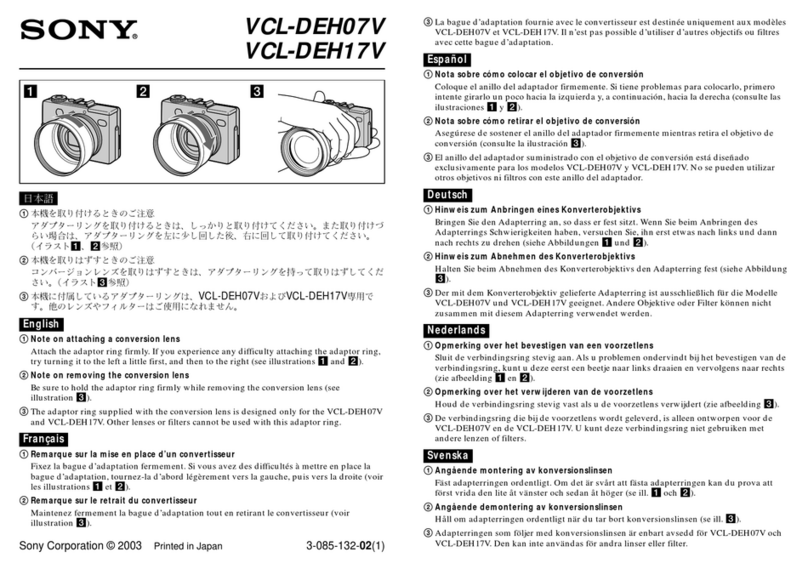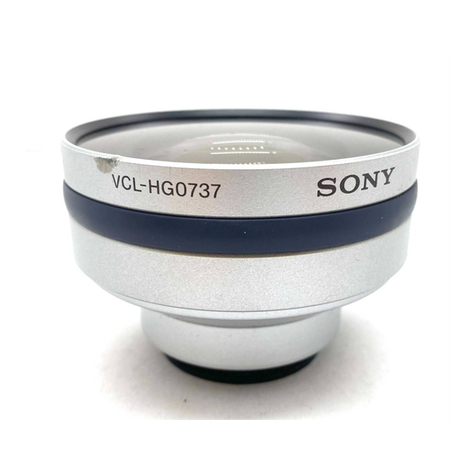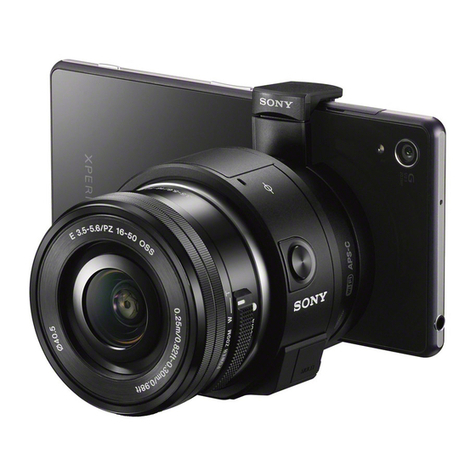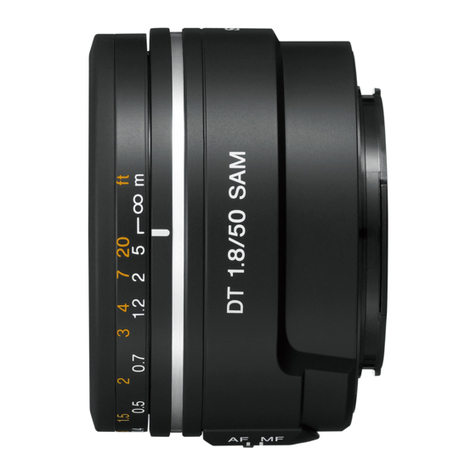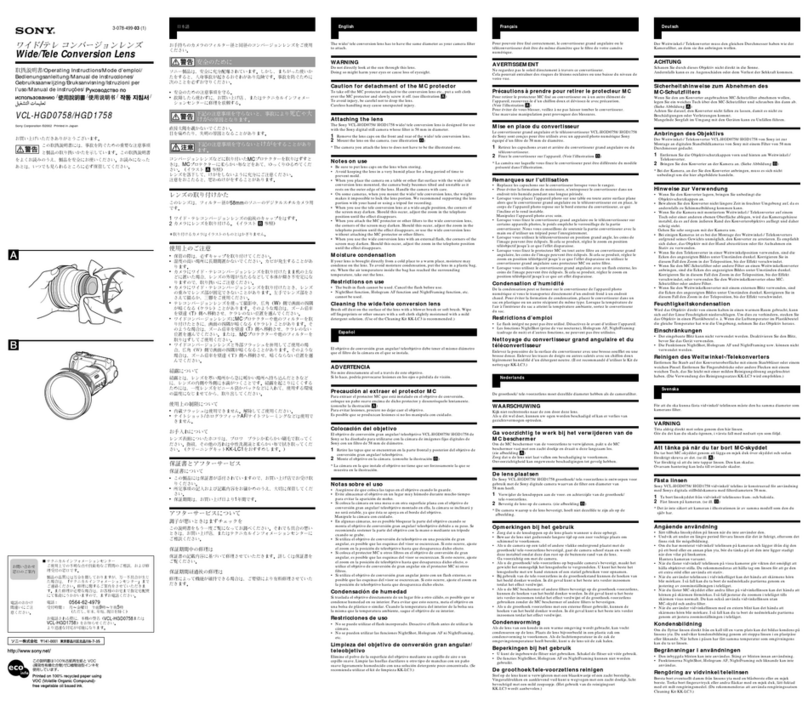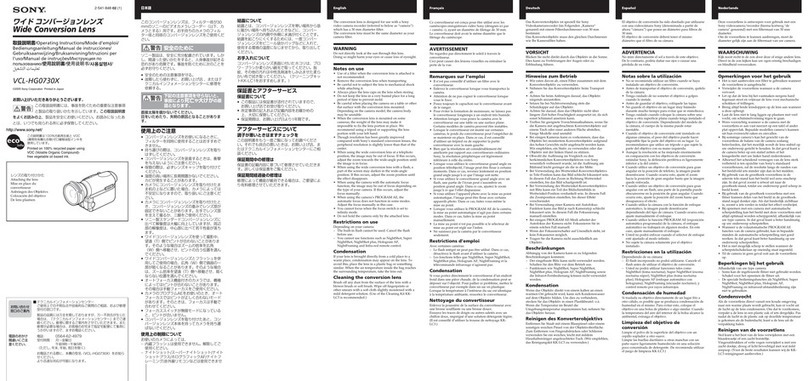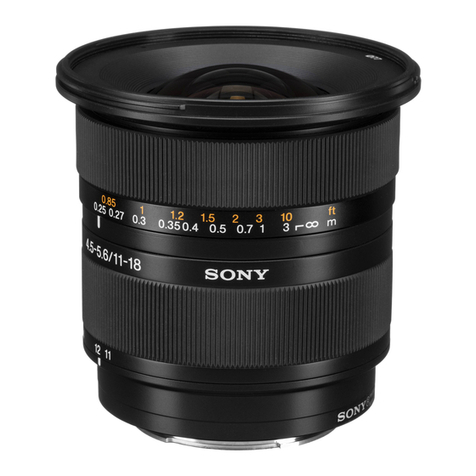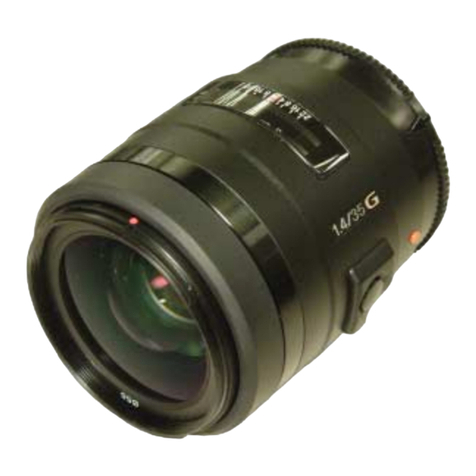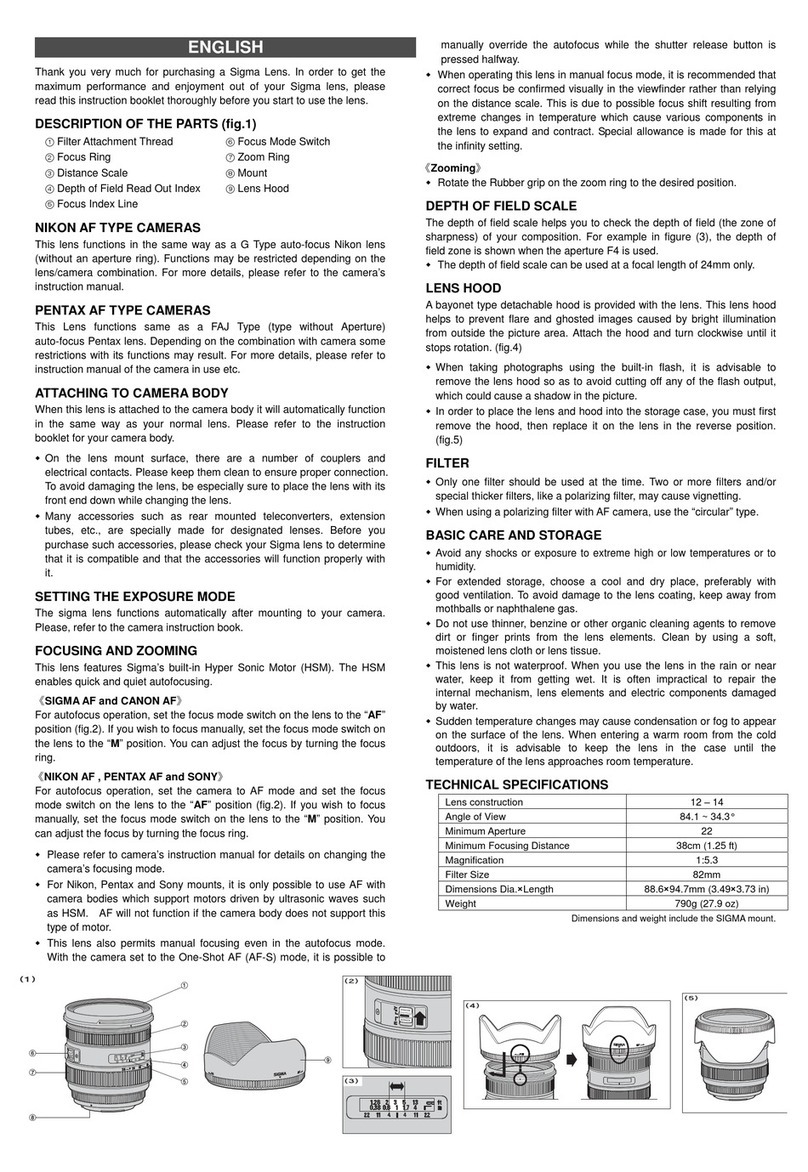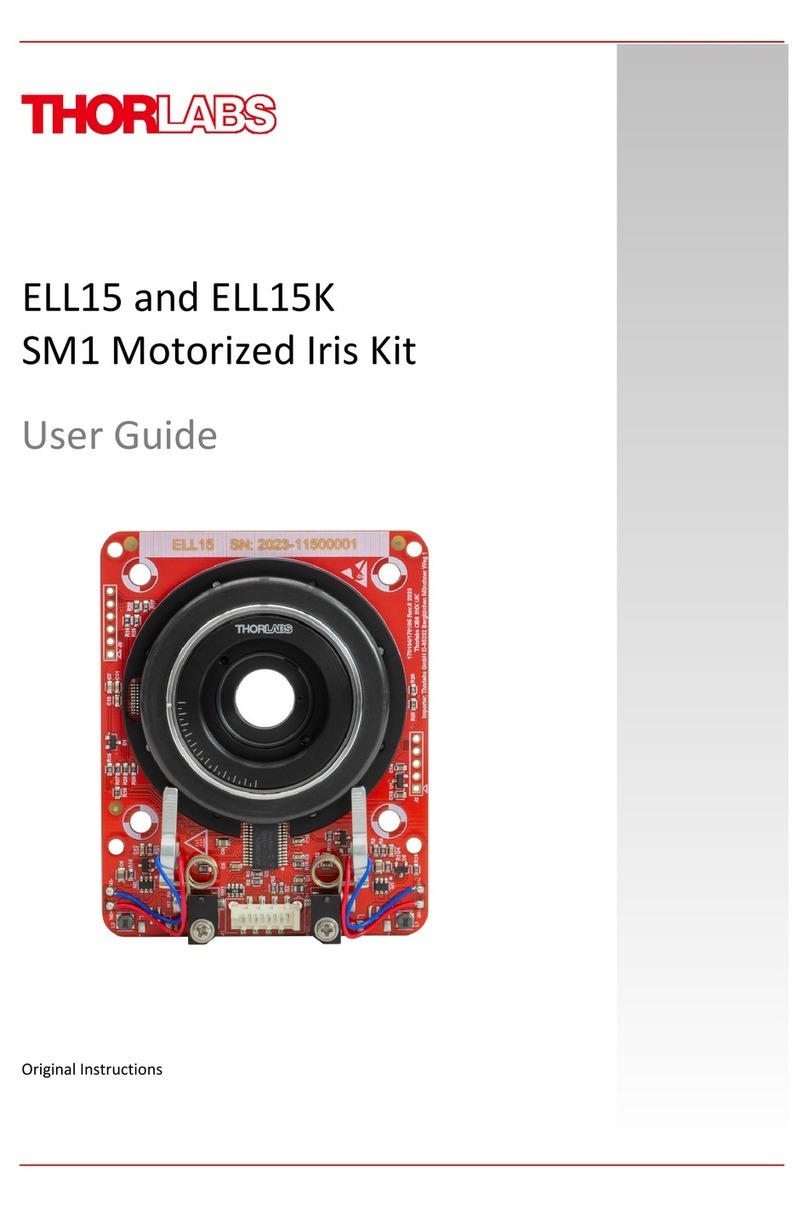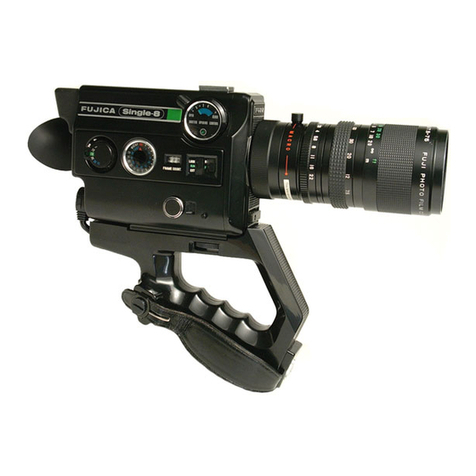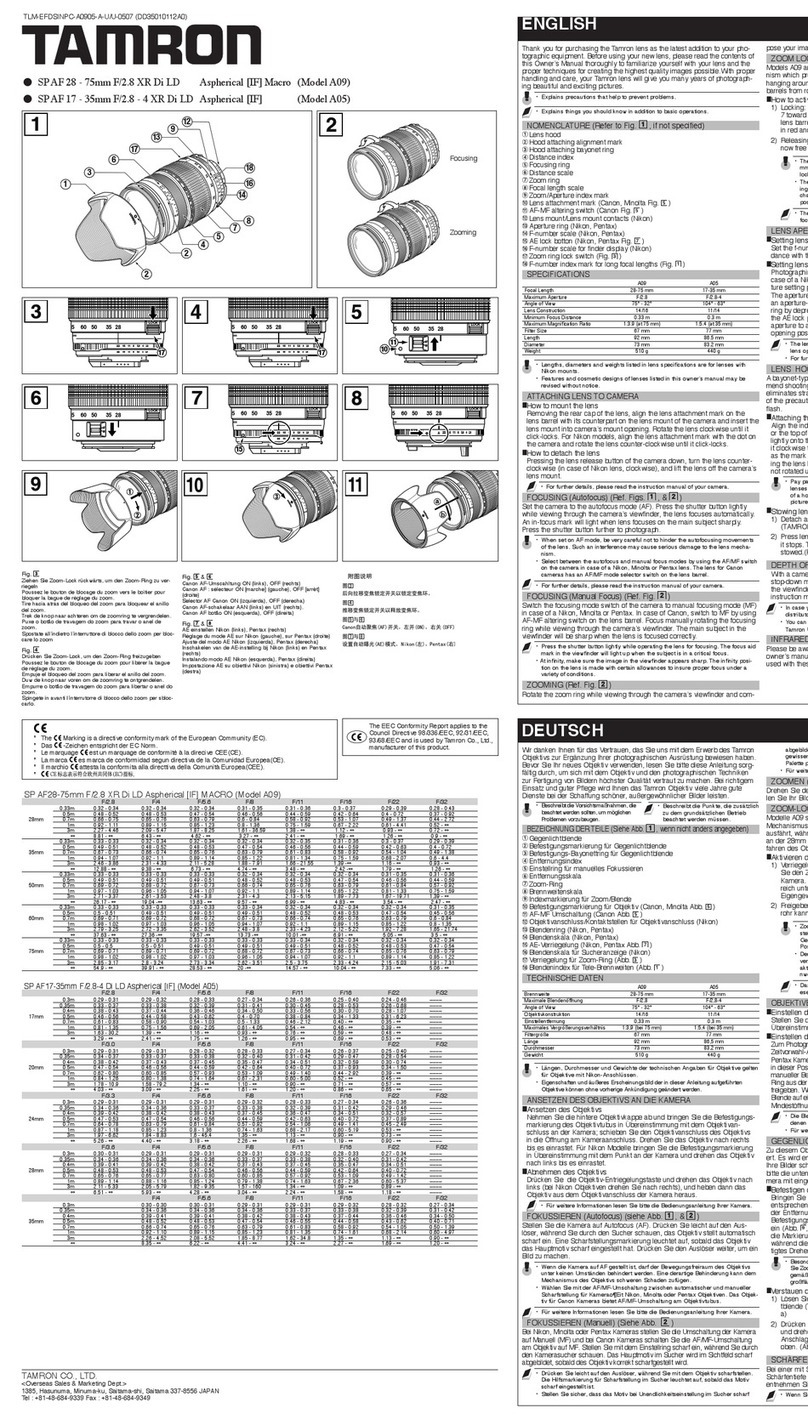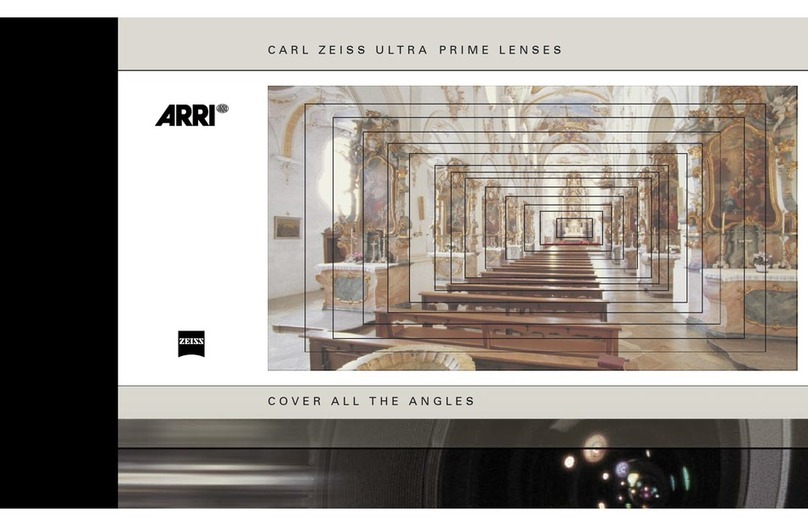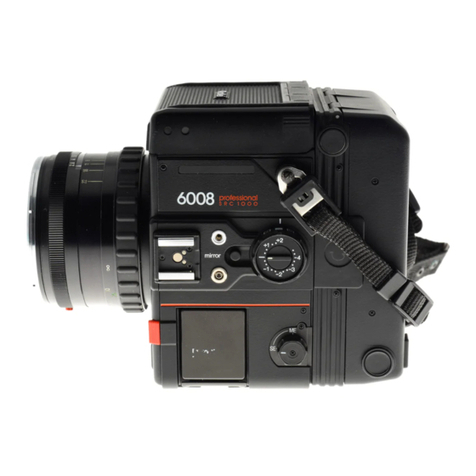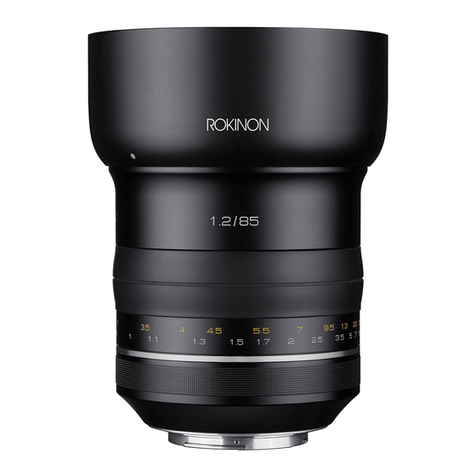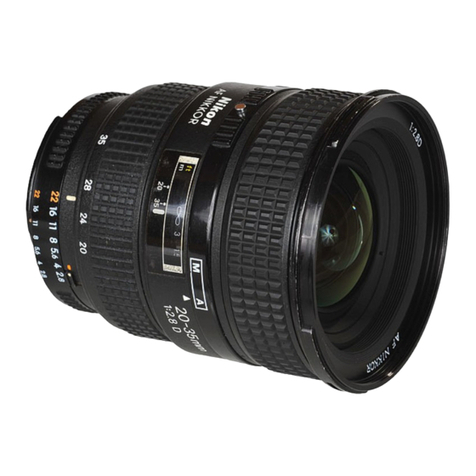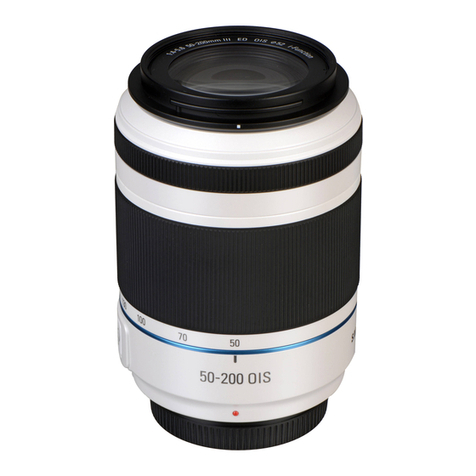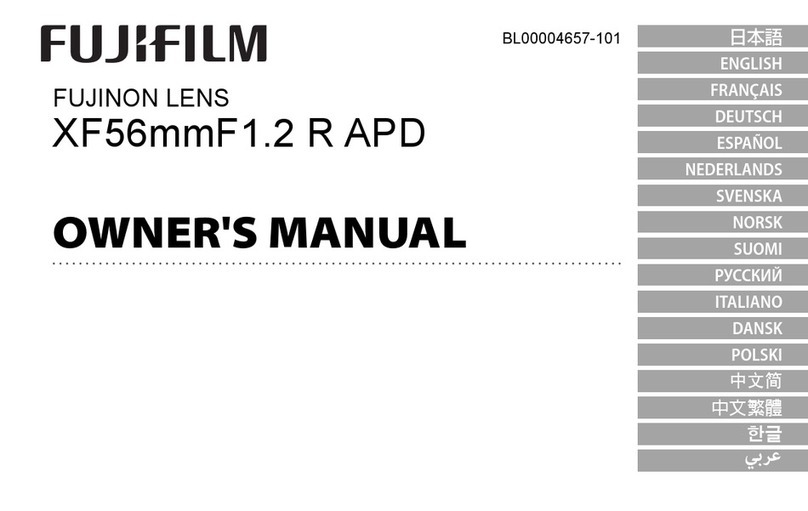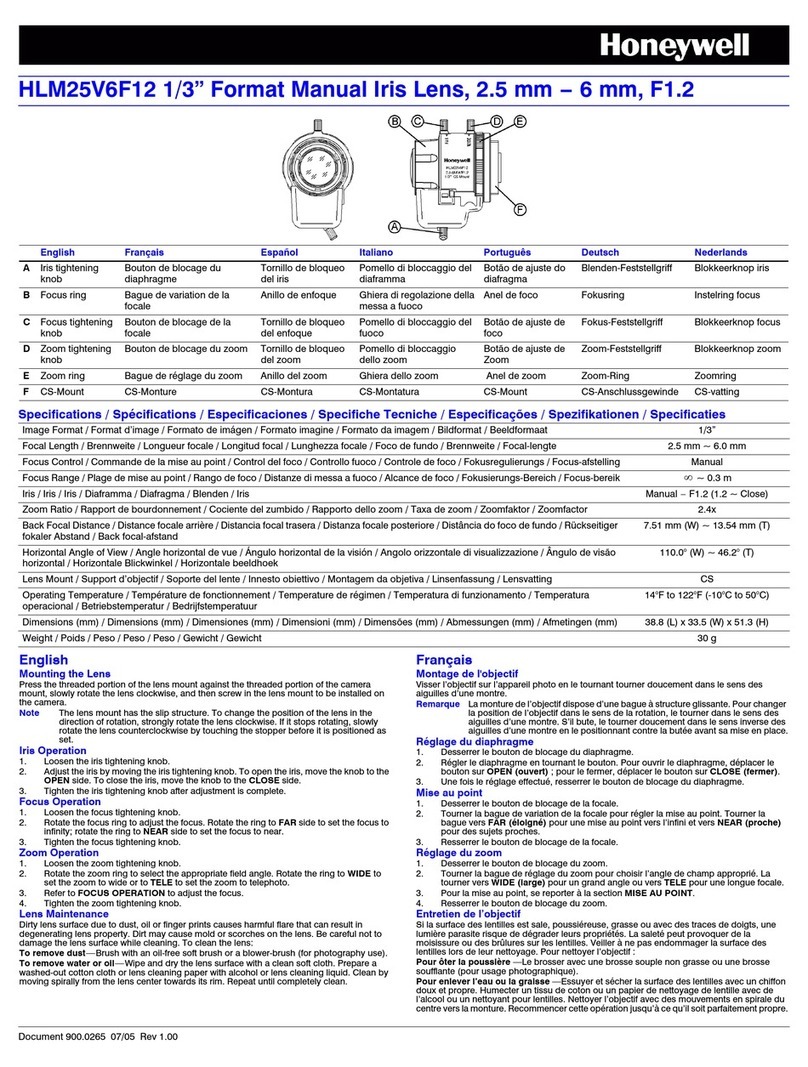
主な仕様
商品名(型名) FE 85mm F1.8 (SEL85F18)
焦点距離(mm) 85
焦点距離イメージ*1(mm) 127.5
レンズ群一枚 8-9
画角1*229°
画角2*219°
最短撮影距離*3
(m) 0.8
最大撮影倍率(倍) 0.13
最小絞り F22
フィルター径(mm) 67
外形寸法(最大径×長さ)
(約:mm) 78×82
質量(約:g) 371
手ブレ補正機能 なし
*1 撮像素子がAPS-Cサイズ相当のレンズ交換式デジタル
カメラ装着時の35mm判換算値を表します。
*2 画角1は35mm判カメラ、画角2はAPS-Cサイズ相当の撮
像素子を搭載したレンズ交換式デジタルカメラでの値
を表します。
*3 最短撮影距離とは、撮像素子面から被写体までの距離を
表します。
ˎ レンズの機構によっては、撮影距離の変化に伴って焦点
距離が変化する場合があります。記載の焦点距離は撮影
距離が無限遠での定義です。
同梱物(()内の数字は個数)
レンズ(1)、レンズフロントキャップ(1)、
レンズリヤキャップ(1)、レンズフード(1)、
印刷物一式
仕様および外観は、改良のため予告なく変更するこ
とがありますが、ご了承ください。
はソニー株式会社の商標です。
This instruction manual explains how to use
lenses. Precautions common to all lenses such
as notes on use are found in the separate
“Precautions before using”. Be sure to read both
documents before using your lens.
This lens is designed for Sony α camera system
E-mount cameras. You cannot use it on A-mount
cameras.
The FE 85mm F1.8 is compatible with the range of a
35mm format image sensor.
A camera equipped with a 35mm format image
sensor can be set to shoot at APS-C size.
For details on how to set your camera, refer to its
instruction manual.
For further information on compatibility, visit the
web site of Sony in your area, or consult your dealer
of Sony or local authorized service facility of Sony.
Notes on Use
ˎWhen carrying a camera with the lens attached,
always firmly hold both the camera and the lens.
Precautions on using a flash
ˎWhen using a flash, always remove the lens hood and
shoot at least 1 m (3.3 feet) away from your subject.
With certain combinations of lens and flash, the lens
may partially block the light of the flash, resulting in a
shadow at the bottom of the picture.
Vignetting
ˎWhen using the lens, the corners of the screen
become darker than the center. To reduce this
phenomena (called vignetting), close the aperture by
1 to 2 stops.
ȎIdentifying the Parts
1 Lens hood index
2 Focusing ring
3 Lens contacts*
4 Focus-hold button
5 Mounting index
6 Focus-mode switch
*Do not touch the lens contacts.
ȏAttaching and Detaching the
Lens
To attach the lens
(See illustration ȏ–ȩ.)
1
R
emove the rear and front lens caps and
the camera body cap.
ˎYou can attach/detach the front lens cap in two
ways, (1) and (2). When you attach/detach the
lens cap with the lens hood attached, use method
(2).
2Align the white index on the lens barrel
with the white index on the camera
(mounting index), then insert the lens
into the camera mount and rotate it
clockwise until it locks.
ˎDo not press the lens release button on the
camera when mounting the lens.
ˎDo not mount the lens at an angle.
To remove the lens
(See illustration ȏ–Ȫ.)
While holding down the lens release
button on the camera, rotate the lens
counterclockwise until it stops, then detach
the lens.
ȐAttaching the Lens Hood
It is recommended that you use a lens hood to
reduce flare and ensure maximum image quality.
Align the red line on the lens hood with the
red line on the lens (lens hood index), then
insert the lens hood into the lens mount and
rotate it clockwise until it clicks into place
and the red dot on the lens hood is aligned
with the red line on the lens.
ˎWhen using a built-in camera flash or an external
flash attached to the camera, remove the lens hood to
avoid blocking the flash light.
ˎWhen storing, fit the lens hood onto the lens
backwards.
ȑFocusing
There are three ways to focus.
ˎAuto focus
The camera focuses automatically.
– Operating sounds may also be recorded during
movie recording.
ˎDMF (Direct manual focus)
After the camera focuses in auto focus, you can
make a fine adjustment manually.
ˎManual focus
You focus manually.
For details on mode settings, refer to the instruction
manual supplied with the camera.
To switch AF (auto focus)/
MF (manual focus)
The focus mode can be switched between AF and
MF on the lens.
For AF photography, both the camera and lens
should be set to AF. For MF photography, either or
both the camera or lens should be set to MF.
To set the focus mode on the lens
Slide the focus-mode switch to the
appropriate mode, AF or MF (1).
ˎRefer to the camera manuals to set the focus mode of
the camera.
ˎIn MF, turn the focusing ring to adjust the focus (2)
while looking through the viewfinder, etc.
ˎThe focus-mode switch of this lens cannot be
switched with some camera models.
For further information on compatibility, visit the web
site of Sony in your area, or consult your dealer of
Sony or local authorized service facility of Sony.
To use a camera equipped with an AF/MF
control button
ˎPress the AF/MF control button to switch AF to MF
when both the camera and lens are set to AF.
ˎPress the AF/MF control button to switch MF to AF
when the camera is set to MF and the lens is set to AF.
ȒUsingFocus-HoldButton
Press the focus-hold button in AF to cancel AF.
The focus is fixed and you can release the shutter
on the fixed focus. Release the focus-hold button
while pressing the shutter button halfway to start
AF again.
ˎThe focus-hold button of this lens does not function
with some camera models.
For further information on compatibility, visit the web
site of Sony in your area, or consult your dealer of
Sony or local authorized service facility of Sony.
Specifications
Product name
(Model name) FE 85mm F1.8 (SEL85F18)
Focal length (mm) 85
35mm equivalent focal
length*1(mm) 127.5
Lens groups-elements 8-9
Angle of view 1*229°
Angle of view 2*219°
Minimum focus*3(m (feet)) 0.8 (2.63)
Maximum magnification (X) 0.13
Minimum aperture f/22
Filter diameter (mm) 67
Dimensions (maximum
diameter × height)
(approx., mm (in.))
78×82
(3 1/8 × 3 1/4)
Mass (approx., g (oz)) 371 (13.1)
Shake compensation
function No
*1This is the equivalent focal length in 35mm format
when mounted on an Interchangeable Lens Digital
Camera equipped with an APS-C sized image sensor.
*2Angle of view 1 is the value for 35mm cameras, and
angle of view 2 is the value for Interchangeable Lens
Digital Cameras equipped with an APS-C sized image
sensor.
*3Minimum focus is the distance from the image sensor
to the subject.
ˎDepending on the lens mechanism, the focal length
may change with any change in shooting distance.
The focal lengths given above assume the lens is
focused at infinity.
Included items
(The number in parentheses indicates the number
of pieces.)
Lens (1), Front lens cap (1), Rear lens cap (1),
Lens hood (1), Set of printed documentation
Design and specifications are subject to change
without notice.
is a trademark of Sony Corporation.
(Suite à la page arrière)
Cette notice explique comment se servir des
objectifs. Les précautions communes à tous
les objectifs, par exemple les remarques sur
l’emploi, se trouvent sur la feuille « Précautions
avant toute utilisation ». Veuillez lire les deux
documents avant d’utiliser votre objectif.
Votre objectif est conçu pour les appareils photo à
monture E de type Sony α. Il ne peut pas être utilisé
pour les appareils photo à monture A.
Le FE 85mm F1.8 est compatible avec la plage d’un
capteur d’image de format 35 mm.
Un appareil photo équipé d’un capteur d’image de
format 35 mm peut être réglé pour la prise de vue
en APS-C.
Pour les détails sur la manière de régler l’appareil
photo, reportez-vous à son mode d’emploi.
Pour plus d’informations sur la compatibilité,
consultez le site de Sony de votre pays, ou adressez-
vous à un revendeur Sony ou à un service après-
vente agréé Sony.
Remarques sur l’emploi
ˎLorsque vous portez un appareil photo avec l’objectif
dessus, tenez toujours fermement l’appareil photo et
l’objectif.
Précautions concernant l’emploi d’un flash
ˎLorsque vous utilisez un flash, retirez toujours le
parasoleil et prenez vos photos à au moins 1 m
(3,3pieds) du sujet. Associé à certains types de flash,
l’objectif peut bloquer partiellement la lumière du
flash et produire un ombre au bas de l’image.
Vignetage
ˎLorsque l’objectif est utilisé, les coins de l’écran
deviennent plus sombres que le centre. Pour réduire
ce phénomène (appelé vignetage), fermez l’ouverture
de 1 ou 2 crans.
ȎIdentification des éléments
1 Repère de parasoleil
2 Bague de mise au point
3 Contacts d’objectif*
4 Bouton de maintien de la mise au point
5 Repère de montage
6 Commutateur de mode de mise au point
*Ne touchez pas les contacts d’objectif.
ȏPose et dépose de l’objectif
Pour poser l’objectif
(Voir l’illustration ȏ–ȩ.)
1Déposez les capuchons d’objectif avant
et arrière et le capuchon de l’appareil
photo.
ˎVous pouvez poser et déposer les capuchons
d’objectif avant de deux façons, (1) et (2). Si vous
posez/déposez le capuchon d’objectif avec le
parasoleil, utilisez la méthode (2).
2Alignez le repère blanc du barillet
d’objectif sur le repère blanc de l’appareil
photo (repère de montage), puis posez
l’objectif sur la monture de l’appareil
photo et tournez-le dans le sens horaire
de sorte qu’il s’encliquette.
ˎN’appuyez pas sur le bouton de libération de
l’objectif sur l’appareil photo lorsque vous posez
l’objectif.
ˎNe posez pas l’objectif de biais.
Pour déposer l’objectif
(Voir l’illustration ȏ–Ȫ.)
Tout en appuyant sur le bouton de libération
de l’objectif sur l’appareil photo, tournez
l’objectif dans le sens antihoraire jusqu’à
l’arrêt, puis déposez l’objectif.
ȐFixation du parasoleil
Il est conseillé d’utiliser un parasoleil pour réduire
la lumière parasite et obtenir la meilleure image
possible.
Alignez la ligne rouge du parasoleil sur
la ligne rouge de l’objectif (repère de
parasoleil), puis insérez le parasoleil sur la
monture d’objectif et tournez-le dans le sens
des aiguilles d’une montre jusqu’à ce qu’il
s’encliquette et le point rouge du parasoleil
s’aligne sur la ligne rouge de l’objectif.
ˎLorsque vous utilisez le flash intégré d’un appareil
photo ou un flash externe fixé à l’appareil photo,
retirez le parasoleil pour éviter de bloquer la lumière
du flash.
ˎPour ranger le parasoleil, insérez-le à l’arrière de
l’objectif.
ȑMise au point
La mise au point peut être faite de trois façons.
ˎAutofocus
L’appareil photo fait automatiquement la mise au
point.
– Les bruits de fonctionnement risquent également
d’être enregistrés pendant l’enregistrement de film.
ˎDMF (Mise au point manuelle directe)
Après la mise au point en autofocus, vous pouvez
effectuer un réglage plus fin manuellement.
ˎMise au point manuelle
Vous faites vous-même la mise au point.
Pour le détail sur les réglages de mode, reportez-
vous au mode d’emploi fourni avec l’appareil photo.


